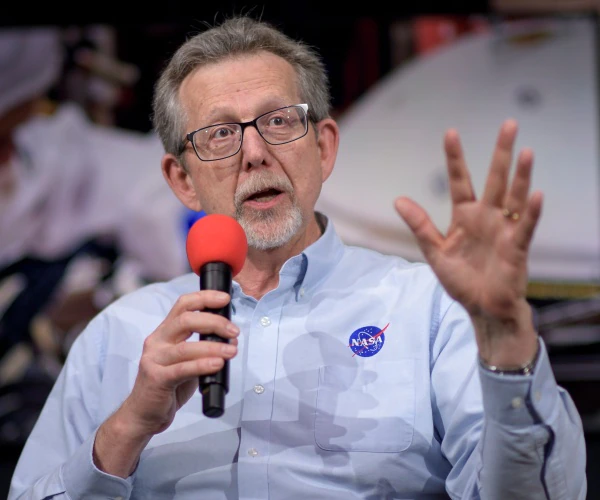
“Jim Green, NASA’s retiring chief scientist, spoke with The New York Times about one of his most significant recent proposals, a scale for verifying the detection of alien life, called the “Confidence of Life Detection” (CoLD) scale.
The scale ranges from one, meaning no life is found, to seven, meaning “we found life.”
The reason we need such a scale, said Green, is that it shows the chances of verifying life on these planets, and, as such, can predict whether the possibility of terraforming, or making them habitable for humans, exists.
Regarding Mars, which is only at a CoLD Level 3, Green told The New York Times that “if a scientist came to me and said, ‘Here’s an instrument that will make it a CoLD Level 4,’ I’d fund that mission in a minute. They’re not jumping to seven, they’re making that next big step, the right step, to make progress to actually finding life in the solar system.”
The difference between the start of the search for life on Mars, beginning with the Viking 1 and 2 landers in 1976, and what we’re doing now is that the current research is much more methodical and much more intelligent in how we recognize “what signatures life can produce over time,” said Green.” Newsmax
Comment: Hopefully, hopefully. pl
https://www.newsmax.com/newsfront/nasa-mars-life-on-mars/2022/01/03/id/1050747/

So solar winds are what have depleted the atmosphere on Mars? I didn’t know that. I wonder if the same thing would happen to us if we lost our magnetic field. I sure hope we are keeping up with our electric bill.
Christian J. Chuba,
Those solar winds are still stripping away what’s left of the Martian atmosphere. Eventually it’ll be like our Moon. Although Mars does appear to have a molten core, it doesn’t have a counter-rotating solid center like Earth to generate a magnetosphere.
I remember reading about the prospect of floating Venusian cities, made possible by the dense atmosphere and atmospheric warmth. I hope to see that one day from afar.
The terraforming referred to in the article is dependent on creating a massive magnetic shield and allowing Mars to repair itself. If we can do that, surely we’d use it to better protect the Earth before we start diddling around with Mars. Venus, like Mars, lacks a magnetosphere. However, Venus does have a “pseudo-magnetosphere” created by the solar wind interaction with her ionosphere. It’s better explained here:
https://sci.esa.int/web/venus-express/-/50246-a-magnetic-surprise-for-venus-express
Here’s an interesting half-hour talk by the foremost expert on the possibility of extraterrestrial life, Prof. Karin Öberg of Harvard. This talk of hers was given at the 2021 Annual Conference of the Society of Catholic Scientists (Nb: Öberg, the youngest woman to become full professor in science at Harvard, is a convert after reading Chesterton).
“The Likelihood of Extraterrestrial Life”
https://www.youtube.com/watch?v=jhiJn_Tdtgs
I’m going with they already know the answer to E.T. life and hope they keep it a secret. We can’t even agree on if masks work despite nobody recommending to use them during the height of flu season going on 50 years.
There is recurring theme now cropping up discussing the possible discovery of alien life within the next few years. One wonders whether this is related to expectations of future discoveries from the James Webb telescope or the creation of the permanent UAP/UFO office and Congressional reporting requirement within the National Defense Authorization Act.
It does appear we are being prepared for some discovery:
https://thehill.com/changing-america/enrichment/arts-culture/587480-nasa-hired-religious-experts-to-predict-how-humans
Another benefit to trying to terraform planets, especially Venus, is that it allows us to test out atmospheric manipulation on another planet just in case we need to do it on Earth. Hmm … would that make it easier or harder to get funding?
Seriously, if you really believe that CO2 induced global warming is going to cause catastrophic climate changes on Earth, wouldn’t you want to study green house gases on another planet?
What can I say, I’m not in sales.
On a more earthy issue I am just seeing news of the huge sudden snow storm in Virginia which has caused a massive traffick jam with people stranded up to 24 hours in the roads of the I-95, also blackouts happening affecting hundreds of thousands..
Wondering whether you all, pilgrims living in Virgina, are ok, especially Colonel Lang..
At least, since you live in such huge homes there, I expect you have wood to heat yourselves…
At the same time it seems there is a fall of many internet services apps, including those Microsoft linked..
Wondering whether WEF took advantage of all this to make things worse…
Stay safe!
Wait, what? We’re worried about a two degree rise in Earth’s temperature and they’re talking about terraforming Venus? Oh well, I guess with imaginary technology we can pursue a lot of imaginary projects.
How do you terraform to counter the effects of low Martian gravity?
Cities in spinning bubbles? Genetic engineering? Or do you accept the loss in bone density, muscle strength, etc?
As long as there is enough atmosphere, why would there be a loss of muscle or bone density?
We would end up doing doing the work appropriate for our physiology. It’s not like we couldn’t find enough mass to move on a planet like Mars. That would only be a problem on something with no gravity, like the space station.
Mars is smaller but Venus is very close to the size of Earth.